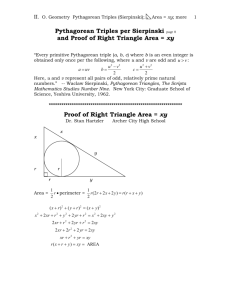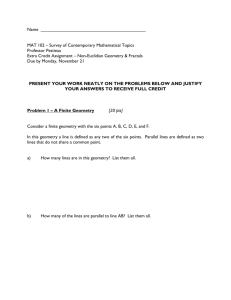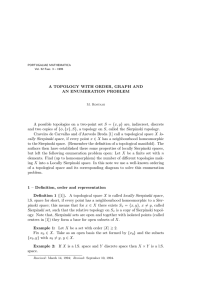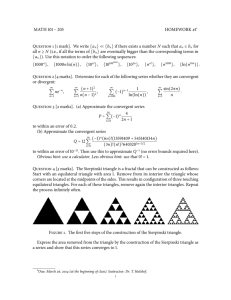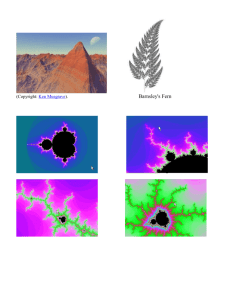A classification of points on the Sierpinski gasket
advertisement
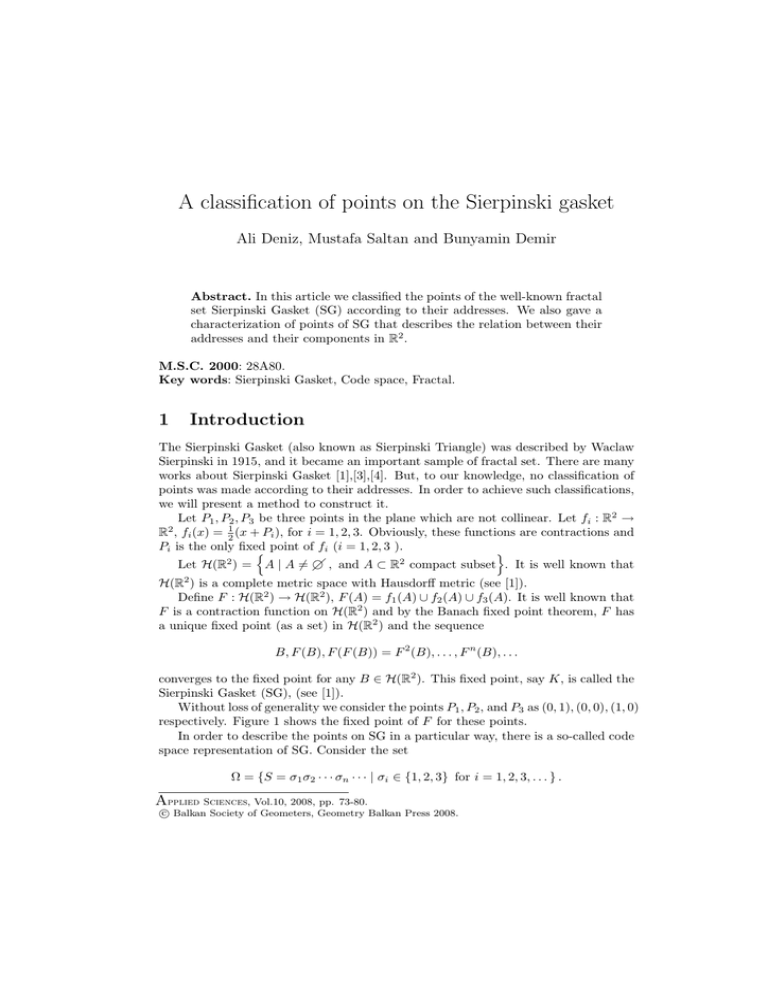
A classification of points on the Sierpinski gasket
Ali Deniz, Mustafa Saltan and Bunyamin Demir
Abstract. In this article we classified the points of the well-known fractal
set Sierpinski Gasket (SG) according to their addresses. We also gave a
characterization of points of SG that describes the relation between their
addresses and their components in R2 .
M.S.C. 2000: 28A80.
Key words: Sierpinski Gasket, Code space, Fractal.
1
Introduction
The Sierpinski Gasket (also known as Sierpinski Triangle) was described by Waclaw
Sierpinski in 1915, and it became an important sample of fractal set. There are many
works about Sierpinski Gasket [1],[3],[4]. But, to our knowledge, no classification of
points was made according to their addresses. In order to achieve such classifications,
we will present a method to construct it.
Let P1 , P2 , P3 be three points in the plane which are not collinear. Let fi : R2 →
2
R , fi (x) = 12 (x + Pi ), for i = 1, 2, 3. Obviously, these functions are contractions and
Pi is the only fixed
o
n point of fi (i = 1, 2, 3 ).
2
f , and A ⊂ R2 compact subset . It is well known that
Let H(R ) = A | A 6= ¡
H(R2 ) is a complete metric space with Hausdorff metric (see [1]).
Define F : H(R2 ) → H(R2 ), F (A) = f1 (A) ∪ f2 (A) ∪ f3 (A). It is well known that
F is a contraction function on H(R2 ) and by the Banach fixed point theorem, F has
a unique fixed point (as a set) in H(R2 ) and the sequence
B, F (B), F (F (B)) = F 2 (B), . . . , F n (B), . . .
converges to the fixed point for any B ∈ H(R2 ). This fixed point, say K, is called the
Sierpinski Gasket (SG), (see [1]).
Without loss of generality we consider the points P1 , P2 , and P3 as (0, 1), (0, 0), (1, 0)
respectively. Figure 1 shows the fixed point of F for these points.
In order to describe the points on SG in a particular way, there is a so-called code
space representation of SG. Consider the set
Ω = {S = σ1 σ2 · · · σn · · · | σi ∈ {1, 2, 3} for i = 1, 2, 3, . . . } .
Applied Sciences, Vol.10, 2008, pp.
73-80.
c Balkan Society of Geometers, Geometry Balkan Press 2008.
°
74
Ali Deniz, Mustafa Saltan and Bunyamin Demir
P1
P2
P3
Figure 1: The fixed point of F
For an element S ∈ Ω, the set
∞
T
n=1
fσ1 ◦ fσ2 ◦ · · · ◦ fσn (K) is a singleton (i.e. set of a
single point). If we denote this singleton by {x} ⊂ K, then the function Φ : Ω −→ K,
Φ(σ1 σ2 · · · σn · · · ) = x
is well-defined. S = σ1 σ2 · · · σn · · · is said to be the address of x. The function Φ is
onto but not one to one, for example the addresses 1222 · · · and 2111 · · · represent
the same point.
Now, let S = σ1 σ2 · · · σn · · · be the address of a point q ∈ K. In order to find q in
K, we iterate K step by step, by taking the compositions of fi ’s (i = 1, 2, 3) according
to the order of S. At the first step we get fσ1 (K). Since fi ’s are contraction functions
with contraction constant 12 , K shrinks by fσ1 towards the point Pσ1 in ratio of 21 .
So, fσ1 (K) is one of the three smaller copies of K. More precisely, f1 (K) is the upper
part of K, f2 (K) is the left-bottom part of K and f3 (K) is the right-bottom part of
K.
f (P1 )
left-top (upper) part
left-bottom part
right-bottom part
f (P2 )
f (P3 )
Figure 2: Components of f (K).
If we continue with the iteration, at the n-th step, we obtain fσ1 ◦fσ2 ◦· · ·◦fσn (K).
For simplicity, say f = fσ1 ◦ fσ2 ◦ · · · ◦ fσn−1 . Thus, if σn = 1 then f ◦ fσn (K) is the
upper part of f (K), if σn = 2 then f ◦ fσn (K) is the left-bottom part of f (K), and if
A classification of points
75
σn = 3 then f ◦ fσn (K) is the right-bottom part of f (K)(see Fig. 2). Table 1 shows
which part is chosen at the n-th step.
σi
1
2
3
left
left
right
Parts
top
bottom
bottom
Table 1: The image of fσi depending on σi .
Example 1: S = 121212 · · · represents the point (0, 23 ) on K. (see Fig. 3.)
f1
f1 ◦ f2
f1 ◦ f2 ◦ f1
Figure 3: Iteration of K with respect to address 121212 · · ·
The components of the point q = {x, y} determined by its address is given by the
infinite sums:
∞
∞
X
X
1
1
x=
xi i , y =
yi i
2
2
i=1
i=1
where
½
xi =
0
1
, σi = 1 or 2
,
,
σi = 3
½
yi =
1
0
,
,
σi = 1
σi = 2 or 3.
Thus, diadic expansions of x and y are written as follows:
x = 0, x1 x2 x3 · · · xn · · · and y = 0, y1 y2 y3 · · · yn · · ·
Conversely, one can obtain the address of a given point q ∈ K from the binary
expansions of its components. Let x and y be the binary expansion of components of
q , say
x = 0, x1 x2 x3 · · · xn · · · and y = 0, y1 y2 y3 · · · yn · · ·
where xi , yi ∈ {0, 1}, and (i = 1, 2, 3, . . . ).
Depending on the first digits, namely x1 and y1 , q is in at least one the following
small squares.
76
Ali Deniz, Mustafa Saltan and Bunyamin Demir
y
(0, 1)
(1, 1)
x1 = 0
x1 = 1
y1 = 1
y1 = 1
x1 = 0
x1 = 1
y1 = 0
y1 = 0
x
(0, 0)
(1, 0)
Thus we can get the first term of the address of q . If x1 = 0, y1 = 1, then q must
be in upper part of K, so σ1 = 1, if x1 = 0, y1 = 0, then σ1 = 2, and if x1 = 1, y1 = 0,
then σ1 = 3. In the case of x1 = y1 = 1, q must be ( 21 , 12 ) and one can choose a
convenient representation of q such that x1 6= 1 or y1 6= 1. Repeating this process,
at the n-th step, depending on xn and yn , q is in at least one of the following small
squares:
(a, b +
1
)
2n−1
(a, b)
(a +
xn = 0
xn = 1
yn = 1
yn = 1
xn = 0
xn = 1
yn = 0
yn = 0
1
1
, b + n−1 )
2n−1
2
(a +
1
, b)
2n−1
1
1
1
1
1
1
where a = x1 + x2 2 + · · · + xn−1 n−1 and b = y1 + y2 2 + · · · + yn−1 n−1 . Again,
2
2
2
2
2
2
in the case of xn = 1 and yn = 1 a convenient representation of q can be chosen, then
we have
1 , (xn , yn ) = (0, 1)
2 , (xn , yn ) = (0, 0)
σn =
3 , (xn , yn ) = (1, 0).
2
Classification of points on the Sierpinski Gasket
We will classify the points of SG with respect to their addresses. First we need to
give following definition.
Definition 1 (Junction Point). Let P1 , P2 , P3 be the vertices of Sierpinski Gasket
and q ∈ K. If there exist finitely many numbers σ1 , σ2 , . . . , σn such that
fσ1 ◦ fσ2 ◦ · · · ◦ fσn (Pi ) = q
where i = 1, 2, or 3 and σj ∈ {1, 2, 3} for j = 1, 2, . . . n, then q is called a junction
point on SG.
A classification of points
77
Our classification consists of three types of points: the junction points, the points
on a segment of SG, the points which are not on a segment of SG.
Theorem 1. Let S be the address of q ∈ K. Then,
i) If S is eventually fixed then q is a junction point.
ii) If an element of the set {1, 2, 3} appears only finitely many times in S, then q
is on a segment of SG.
iii) If each of the elements of {1, 2, 3} appears infinitely many times in S then q is
not on a segment of SG.
Proof.
i) Let S = σ1 σ2 · · · σn σσσ · · · be the address of q ∈ K. Consider first n
terms of S which is not fixed and say f = fσ1 ◦ fσ2 ◦ · · · ◦ fσn .
Applying f to SG, we get the part of SG whose vertices are f (P1 ), f (P2 ) and
f (P3 ). In the next step of the iteration, we obtain f ◦ fσ (K) by applying fσ
to f (K). By definition, depending on the value of σ, f ◦ fσ (K) corresponds to
a smaller part of the triangle f (K) divided according to the rule given above.
This has been illustrated as the shaded triangle in Figure 4, when σ = 1.
f (P1 ) = f ◦ fσ (P1 )
f ◦ fσ (K)
f ◦ fσ (P2 )
f (P2 )
f ◦ fσ (P3 )
f (P3 )
Figure 4: (n + 1)-th step of the iteration when σ = 1.
Continuing with the iteration, in the (n + k)-th step, we obtain f ◦ fσk (K) for
(k = 1, 2, . . . ). (Here fσk denotes the composition fσ ◦ fσ ◦ · · · fσ , k-times). Each
time we apply fσ to f ◦fσk (K), we get a small one third part of f ◦fσk (K) getting
closer to the vertex f (Pσ ).
Thus, choosing k large enough, we can make f ◦ fσk (K) close to f (Pσ ) as close
as we want. This means if k goes to infinity, f ◦ fσk (K) converges to the vertex
f (Pσ ), so q is a junction point.
ii) Let S = σ1 σ2 · · · σn · · · be the address of q ∈ K and one of the elements of
{1, 2, 3} appears only finitely many times in S. Let us suppose that the finitely
used element is 3, the other cases are similar.
Let σn be the last digit where 3 occurs. Thus we can say if k > n then σk ∈
{1, 2}. This means that after the n-th step of the iteration, only f1 and f2 are
used to determine the location of q.
78
Ali Deniz, Mustafa Saltan and Bunyamin Demir
Let f = fσ1 ◦ fσ2 ◦ · · · ◦ fσn . Then f (K) is the part of SG whose vertices are
f (P1 ), f (P2 ), f (P3 ). In (n+1)-th step, if σn+1 = 1 then f ◦fσn+1 (K) is the upper
part of f (K) and if σn+1 = 2 then f ◦ fσn+1 (K) is left-bottom part of f (K). In
both cases f ◦ fσn+1 (K) contains a subsegment of the segment | f (P1 )f (P2 ) |.
The furthest point of f ◦ fσn+1 (K) to | f (P1 )f (P2 ) | is f ◦ fσn+1 (P3 ) and since
1
we are in the (n + 1)-th step, its distance is n+1 . This situation continues in
2
the subsequent steps. That is, for k ≥ n, f ◦ fσn+1 ◦ · · · ◦ fσk (K) contains a
subsegment of | f (P1 )f (P2 ) |. Here f ◦ fσn+1 ◦ · · · ◦ fσk (P3 ) is the furthest point
1
to | f (P1 )f (P2 ) |, and its distance is k . As k goes to infinity this distance
2
tends to zero which means q is on | f (P1 )f (P2 ) |.
f (P1 )
f (P2 )
f (P3 )
Figure 5: q is on the segment | f (P1 )f (P2 ) |, if the number 3 appears only finitely
many times in S.
iii) Let S = σ1 σ2 · · · σn · · · be the address of q ∈ K and each of the elements of
{1, 2, 3} appears infinitely many times in S.
Thus for each m ∈ N, there exist numbers N1 , N2 , N3 ∈ N such that Ni > m
(i = 1, 2, 3) and σN1 = 1, σN2 = 2 and σN3 = 3. Now, fix m ∈ N and let
f = fσ1 ◦ fσ2 ◦ · · · ◦ fσm . We claim that q is not on the segment | f (P1 )f (P2 ) |.
To prove this, choose N3 > m such that σN3 = 3. Since fσ1 ◦fσ2 ◦· · ·◦fσ(N3 −1) (K)
shrinks by fσN3 towards the point fσ1 ◦ fσ2 ◦ · · · ◦ fσ(N3 −1) (P3 ) in ratio of 21 , then
d(q, | f (P1 )f (P2 ) |) ≥
1
2N3
where d(q, | f (P1 )f (P2 ) |) is the distance between q and the segment | f (P1 )f (P2 ) |.
Hence, q can not be on the segment | f (P1 )f (P2 ) |.
Similarly q can not be on the segments | f (P1 )f (P3 ) | and | f (P2 )f (P3 ) |. Since
m ∈ N is arbitrary, q is not on a segment of SG.
Now, we will give another characterization of points of SG that describes the
relation between their addresses and their components.
Theorem 2. Let q be a point on SG. q has rational coordinates in the plane if and
only if its address is eventually periodic.
A classification of points
79
Proof. Let us prove, first, that a point which has eventually periodic address has
rational coordinates. Let
S = σ1 σ2 · · · σn σn+1 · · · σn+p σn+1 · · · σn+p · · ·
be the address of q with period p, where σi ∈ {1, 2, 3}. Consider the diadic expansions
of the components of q = (x, y):
x = 0, x1 x2 x3 · · · xn · · ·
y = 0, y1 y2 y3 · · · yn · · ·
where xi , yi ∈ {0, 1} for i ∈ N. Periodicity of S implies that above expansions are
also periodic. Moreover, their periods are the same as the address of q, namely p.
We can write the coordinates of q in the plane as
x=
∞
X
xi
i=1
1
,
2i
y=
∞
X
yi
i=1
1
.
2i
The sum of the first n terms (aperiodic parts) of these sums are rational, thus we
can consider the following remainders:
x=
∞
X
i=n+1
xi
1
,
2i
y=
∞
X
i=n+1
yi
1
.
2i
For the first component x, this remainder can be written as follows
¶
¶
µ
µ
∞
X
1
1
1
1
1
xi i = xn+1
+
+
·
·
·
+
·
·
·
+
x
+
+
·
·
·
n+p
2
2n+1
2n+p+1
2n+p
2n+2p
i=n+1
µ
¶³
1
1
xn+1
xn+2
xn+p ´
=
1 + p + 2p + · · ·
+
+
·
·
·
+
2
2
2n+1
2n+2
2n+p
³
´
p
2
xn+1
xn+2
xn+p
=
+ n+2 + · · · + n+p
p
n+1
2 −1 2
2
2
which is rational. Similarly y is also rational.
Let us now prove the sufficiency: if the components of q are rational then the
address of q is eventually periodic. Write the binary expansions of x and y,
x =
y =
0, x1 x2 · · · xn xn+1 · · · xn+p xn+1 · · · xn+p · · ·
0, y1 y2 · · · yn yn+1 · · · yn+p yn+1 · · · yn+p · · ·
where xi , yi ∈ {0, 1}. Forming the pairs (xn , yn ), we get a new sequence which is
also eventually periodic. Using the method in the introduction, we have the address
S = σ1 σ2 · · · σn · · · of q. Periodicity of (xn , yn ) provides that S is periodic.
Theorem 2 is stated for the points P1 = (0, 1), P2 = (0, 0), P3 = (1, 0). As a
result, we can give the following corollary for three points in the plane which are not
collinear.
Corollary 1. Let P1 , P2 , P3 be three points in the plane which are not collinear. A
point q on SG (whose vertices are P1 , P2 , P3 ) has eventually periodic address if and
only if q is a linear combination of P1 , P2 , P3 with rational coefficients.
80
Ali Deniz, Mustafa Saltan and Bunyamin Demir
References
[1] M. F. Barnsley, Fractals Everywhere, Academic Press, Boston, 1993.
[2] M. F. Barnsley, Super Fractals, Cambridge Univ. Press, 2006.
[3] H. O. Peitgen, H. Jrgens, S. Dietmar, Chaos and Fractals, Second Ed., SpringerVerlag, 2004.
[4] M. Yamaguti, M. Hata, J. Kigami, Mathematics of Fractals, Trans. Math. Monog.
Vol. 167, A.M.S., 1997.
Authors’ address:
Ali Deniz, Mustafa Saltan and Bunyamin Demir
Anadolu University, Department of Mathematics,
26470 Eskisehir, Turkey.
E-mail: adeniz@anadolu.edu.tr, msaltan@anadolu.edu.tr, bdemir@anadolu.edu.tr
